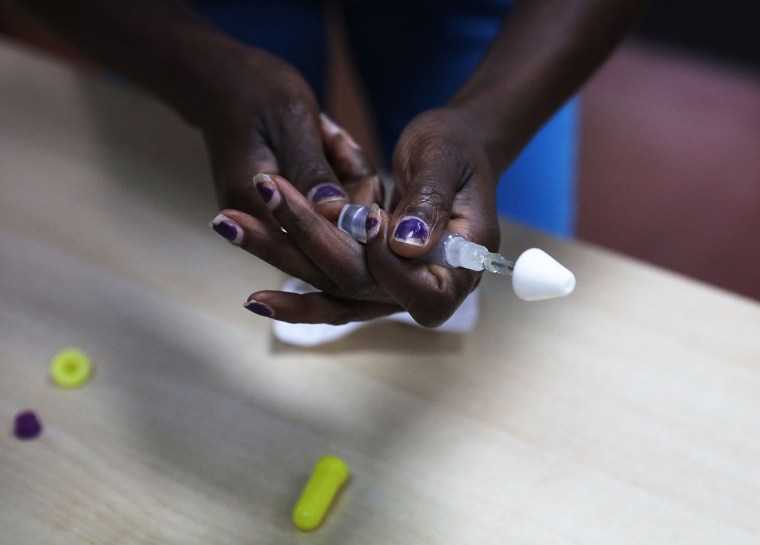Anybody who knows someone at risk of an opioid overdose should always carry naloxone, the anti-overdose drug, Surgeon General Dr. Jerome Adams said Thursday. He said his office was working with manufacturers and insurance companies to help make it possible.
At the same time, the National Institutes of Health announced a near-doubling of its budget for opioid addiction research, and the Food and Drug Administration commissioner said his agency would do more to stop the import of illicit opioids.
A bill to give the FDA more powers to regulate how opioids are packaged, and to help states treat and rehabilitate people with opioid addiction, was also moving through the Senate.
It may sound like a lot is suddenly happening to fight the opioid crisis. But while each announcement is welcome, experts said, it will still be difficult to create action right away.
“We are hearing rhetoric,” said Lindsey Vuolo, associate director of health law and policy at the National Center on Addiction and Substance Abuse. “They are all important steps but none of them are sufficient to fully address the problem."
Adams said he wanted to make it possible for just about everyone in some communities to be carrying naloxone, a drug that can reverse an opioid overdose almost immediately.
“With over half of overdoses occurring at home and three quarters of overdoses occurring in a nonmedical setting, we know we can't rely solely on first responders to save lives,” Adams told NBC News.
“In some scenarios everyone in a community should have naloxone if there's a high proportion of individuals who are at elevated risk.”
Adams said his office had helped negotiate some discounts with companies that make naloxone, including Kaleo, which makes an auto-injector for naloxone and Adapt, which makes Narcan, a nasal spray version of the drug.
“Kaleo has agreed to discount their price 90 percent to federal and state governments and to entities that have funding through federal and state government programs. And they also have a program to provide that medication for free to individuals who fall in the in the gap,” Adams said.
In six states — Arizona, California, Colorado, Missouri, Nevada and Ohio — people with commercial health insurance can call a pharmacy and get naloxone delivered at no cost, Kaleo said.
Baltimore City Health Commissioner Dr. Leana Wen said the plan is a good first step.
“Our problem isn’t the policies. It’s access to the medications,” Wen said. “We are being priced out of our ability to save lives.”
Wen said Baltimore needs $10 million a year from the federal government to fight the opioid epidemic.
“It cannot be one-time funding. It must be sustained,” she said. The discounted price offered by Kaleo is still too expensive," she said.
“We are having to ration naloxone,” Wen added. “Between now and July I only have about 160 kits of naloxone left to give out, which means that every day, I have to make a decision about who is going to get this naloxone and who will have to go without.”
There is no question that naloxone works, Wen said.
“I'm an emergency physician and in the ER," she said. "I've used naloxone hundreds of times and I've seen how someone who is about to die from an opioid overdose, if they're given naloxone, they'll be walking and talking again in seconds."
And there’s no question that the U.S. is suffering through a terrible epidemic of opioid abuse.
The CDC says synthetic opioid overdoses killed 20,000 people in 2016. Opioid overdose deaths are so bad they have helped drive down U.S. life expectancy.
The Kaiser Family Foundation said in a new report that the cost of treating opioid addiction and overdose has gone up eight-fold for private health insurance companies since 2004, from $300 million dollars in 2004 to $2.6 billion in 2016.
The federal government is under pressure to act.
The NIH said it was doubling its research budget for opioid abuse from $600 million to $1.1 billion and would focus on finding safer ways to treat pain and better ways to treat addiction and abuse disorders.
A bill in discussion in the Senate would provide grants for communities to operate opioid recovery centers and would give the FDA power to force companies to package opioids in blister packs to deter abuse.
FDA commissioner Dr. Scott Gottlieb said he would work to help better educate and guide doctors about the best ways to treat pain, including prescribing far lower doses of opioids.
Gottlieb said he was going to speak with internet companies to see if they could help stop illegal sales of opioids. “The easy availability and online purchase of these products from illegal drug peddlers is rampant and fuels the opioid crisis,” Gottlieb told the National Prescription Drug Abuse and Heroin Summit, being held in Atlanta.
“We find offers to purchase opioids all over social media and the Internet, including Twitter, Facebook, Instagram, Reddit, Google, Yahoo, and Bing.”
These are all positive steps, said Vuolo.
“There are some efforts that are being made, but we are not seeing the wholesale, comprehensive approach that is needed,” she said.
“We have effective treatments for opioid addiction, but people aren’t getting them. The reality is the vast majority of people are unable to find care, they are unable to pay for it, or they’re not receiving care that’s effective,” she added.


